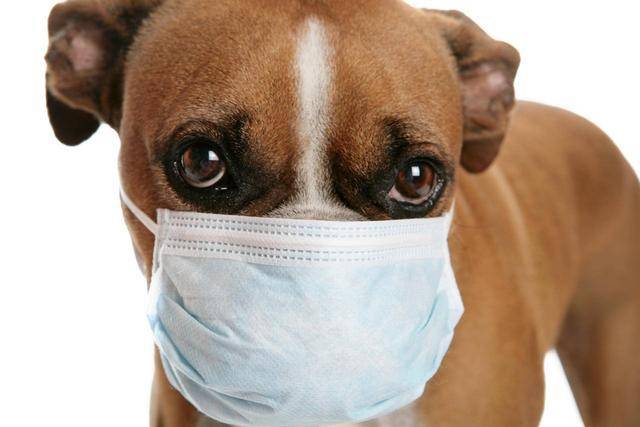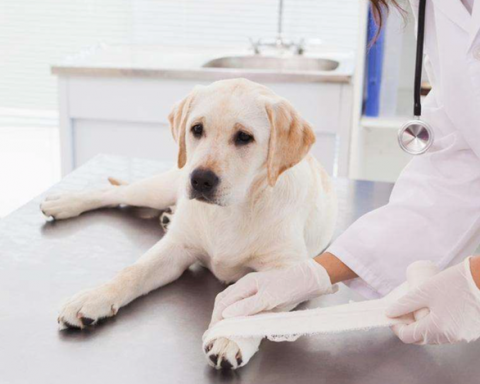Food poisoning
Poisoning occurs when dogs ingest spoiled fish, meat, yogurt and other foods due to the larger amounts of Aspergillus, staphylococcal toxins, salmonella enterotoxins and clostridium botulinum toxins contained in these spoiled foods.
Spoiled fish, because of contamination with Aspergillus, causes protein breakdown and production of histamine. The incubation period for histamine poisoning is no more than 2 hours, with sudden vomiting, dysentery, dyspnea, snotty nose, dilated pupils, ataxia, the dog may be comatose, hindquarter paralysis, weakness, hematuria, and black feces.
Treatment of rotting fish poisoning can be intravenous or subcutaneous injection of glucose, vitamin C, internal phenylephrine, intramuscular or subcutaneous injection of cyanotoxin staphylococcal toxin poisoning can cause symptoms of acute gastroenteritis, sick dogs vomiting, abdominal pain, dysentery. In severe cases, respiratory distress, convulsions and convulsions occur. Treatment is with emesis, rehydration and symptomatic therapy. Gastric lavage and enema can be used if necessary.
Clostridium botulinum poisoning causes motor paralysis, coma and even death in dogs. Symptoms in dogs with Clostridium botulinum poisoning are related to the amount of ingestion. Initially, the neck and shoulder muscles are paralyzed, and gradually the limbs are paralyzed, the reaction is slow, the pupils are dilated, it is difficult to swallow, the saliva flows out, and the two ears are drooping. Conjunctivitis and ulcerative keratitis are common in the eyes. Finally, death is caused by respiratory paralysis. Clostridium botulinum poisoning has a short course and a high mortality rate. Antitoxin is injected immediately after the onset of the disease, intravenously or intramuscularly. Symptomatic treatment can be used to wash the stomach with 0.01% potassium permanganate solution, administer laxatives or enemas, intravenous fluids, and intramuscular penicillin. The best way to prevent this disease is that the dog’s food should be cooked and not left for a long time.
Poisoning by rodenticides (Antrodynamics)
This is a strong rodenticide, white odorless crystalline powder, causing increased pulmonary capillary permeability, plasma into the lung tissue in large quantities, resulting in pulmonary edema. Dogs ingested a few minutes to a few hours, vomiting, foaming at the mouth, followed by diarrhea, coughing, dyspnea, depression, visible mucous membrane cyanosis, nostrils out of foamy blood-colored mucus. Generally 10-12 hours after ingestion, coma and drowsiness appear, a few died within 2-4 hours after ingestion. There is no specific antidote for this poisoning, but emetic, gastric lavage, diaphoretic and diuretic methods can be used.
Zinc phosphide poisoning
This is a commonly used rodenticide, gray powder. A few days after ingestion, it mixes with water and stomach acid in the stomach, releasing phosphine gas and causing severe gastroenteritis. Sick dogs suffer from abdominal pain, no food, vomiting, coma and lethargy, and fast and deep breathing. Suffocation, diarrhea, blood in feces. Treatment can be instilled with 0.2%-0.5% CuSO4. solution of 10-30 ml to induce vomiting and discharge the poison in the stomach. Gastric lavage can be performed with 0.02% KMnO4 solution, followed by 15 g Na2SO4 to induce diarrhea. Intravenous hypertonic glucose solution facilitates liver preservation.
Organic fluoride rodenticide poisoning
This is a highly toxic drug, 2-3 days after eating the dog restlessness, vomiting, gastrointestinal hyperfunction, running, barking, generalized paroxysmal spasm, lasting about 1 minute, and finally died. Treatment can be intramuscular injection of defluridine, 0.1-0.2 grams per kilogram of body weight, the first dosage of 1/2 of the amount of the whole day, the remaining 1/2 amount divided into 4 parts, every 2 hours injection. Cooperate with emetic and gastric lavage. Feed raw egg white to the sick dog, which is good for protecting the mucous membrane of the digestive tract. Intravenous calcium gluconate 5-10 ml is beneficial.
Organophosphorus pesticide poisoning
Organophosphorus is widely used in agriculture as insecticide, such as trichlorfon, lego, dichlorvos and so on. Accidental ingestion causes massive salivation, tearing, diarrhea, abdominal pain, urinary incontinence, respiratory distress, coughing, cyanosis of the conjunctiva, muscle twitching, followed by paralysis, pupil constriction and coma in dogs. Mostly die due to respiratory impairment. For treatment, atropine sulfate is first slowly injected intravenously at 0.05 mg per kilogram of body weight, followed by subcutaneous or intramuscular injection of 0.15 mg per kilogram of body weight after an interval of 6 hours. Atropine is potentiated by antiphosphidine. Drugs that relieve muscle spasms help to moderate symptoms. Individual dogs are allergic to antiphosphidine and chlorophosphidine.
Chlorinated hydrocarbon poisoning
This type of pesticide includes DDT, hexachloroethylene, and others. Causes extreme excitement, mania or highly depressed dogs head and neck muscles first tremor, then spread to the whole body, muscle spasm contraction, followed by depression; more than the flow of birth, no or little food, diarrhea. Treatment may be by cleansing and gastric lavage, followed by diarrhea with a salt laxative. Administration of tranquilizers can symptomatically treat the dog’s over-excitement. Intravenous fluids should be given as the dog is dehydrated and not eating.
Poisoning and First Aid for Household Products for Pets
Arsenide poisoning
That is, arsenic poisoning. Because it contains sodium arsenite, calcium arsenate, lead arsenate, etc., the dog accidentally eaten poisoning. Acutely poisoned dogs suddenly severe abdominal pain, muscle tremors, salivation, vomiting, hobbling, diarrhea, thirst, paralysis of the hind limbs of the sick dog, oral mucosal swelling, the gums become dark black, in severe cases, can be seen oral mucosal ulceration, shedding. Individual dogs are excited, convulsions, sweating, body endings cold, some parts of the muscle paralysis. Male dogs can be seen to be dislodged from the penis. Treatment of arsenic agent poisoning. Commonly used 10% of the di-liquid propanol 1-2 ml, the interval of 1-2 hours intramuscular injection once, even with 3-4 times. It can also be injected intravenously with 50% sodium thiosulfate solution 50-80 ml.
Phenol poisoning
Phenolic preparations are widely used in public health disinfection, and in veterinary clinical work, and are commonly found in preparations such as carbolic acid, laisodil, guaiacol, and xylene. Phenol is used as a corrosive and sterilizing agent to disinfect floors, kennels, and large eating utensils, and if licked and ingested by dogs in certain amounts, symptoms of poisoning can occur. Phenol preparations can cause neurological damage. The skin in contact with phenol preparations is red and oozing. The sick dog is mentally unstable, vomits, has tonic spasms, and is paralyzed. To treat, the local skin should be washed with water, then the skin of the infested area should be rinsed with 10% ethanol to neutralize the phenol, and the affected area should be wrapped with an oil-impregnated dressing to further eliminate the phenol. To treat dogs poisoned by ingesting phenol preparations, the stomach can be washed, milk, egg whites or activated charcoal can be given orally; diuretics can be given intravenously; and intramuscular isoproterenol can be injected to enhance blood circulation to fight shock.
Snake Venom Poisoning
Snake venom poisoning often occurs after being bitten by poisonous snakes. This situation is mainly seen in the police dog, hunting dog in the jungle area to perform the task, or mountainous areas of the family dog to go out to forage for food. Bites from venomous snakes are most common on the face and limbs. The closer the bite is to the central or vascularized area, the more severe the symptoms. Symptoms also vary according to the type of snake venom.
1. Blood circulation toxins.
Such as viper, belly snake, bamboo leaf green, five-step snake, etc.. It causes rapid swelling, hardening, bleeding, severe pain, purple-black skin, often skin necrosis and enlarged lymph nodes in the bitten area. After 6-8 hours it can spread to the head, neck, limbs and lower back. The sick dog trembles, body temperature rises, heartbeat accelerates, respiratory distress, unable to stand. Nosebleeds, blood in the urine, convulsions. If the bite is not effectively treated within 4 hours it will eventually die of heart failure or shock.
2. Neurotoxins.
This includes the toxins secreted by snakes such as golden ring snakes and silver ring snakes. After the bite, the local symptoms are not obvious, bleeding is little, redness, swelling and fever are slight. But within a few hours after the injury, there are acute systemic symptoms, the sick dog is excited and restless, moaning in pain, the whole body muscle trembling, foaming, dysphagia, respiratory difficulties, and finally lying on the ground, the whole body convulsions, respiratory muscle paralysis and death.
3. Mixed toxins.
The venom of cobra and king cobra belongs to mixed toxins. Local wounds are red, swollen, hot and painful, and necrosis may occur. After the toxin is absorbed, the systemic symptoms are severe and complex, with both neurological symptoms and damage caused by blood circulation of the toxin, and finally, the dog dies of asphyxia or cardio-dynamic failure.
Snakebites should be treated as quickly as possible
First, the spread of venom should be prevented. Tie the wound tightly above the wound with cloth tape, string, etc., taking care that the tourniquet is not loose, but can only be used for 2 hours, otherwise it causes ischemic necrosis at the distal end of the area tied tightly. It can also be loosened every 15-20 minutes for l-2 minutes.
Second, the venom should be removed. It can be thoroughly rinsed with water or ammonia, or 1:5000 potassium permanganate solution. Then the wound and the surrounding red and swollen part should be stabbed with a three-pronged needle, or make a straight line incision through the snake’s tooth marks to detoxify, and if there are snake venomous teeth, they should be taken out immediately.
Third, the venom should be neutralized. Intravenous injection of monovalent or polyvalent antivenom. To prevent allergy, 0.o1% epinephrine can be used.
Fourth, local symptomatic treatment. Cold compresses can be used, topical painkillers; corticosteroids and blood volume expanders can be given to treat toxic shock. Antimicrobial agents can be used to prevent infection; tetanus antitoxin can be injected to prevent tetanus.


